
It allows to keep PV going, with more focus towards AI, but keeping be one of the few truly independent places.
-
I really would love to turn off digital sharpening in my GH2, it makes some white artifacts around small details that flashes when you move the camera... Will this be possible with future hacks ?
-
I have the panny/leica 25mm. While I love sharp lenses, I do see an increase in the stacatto effect. After comparing it with the voightlander, which is softer, it's clearly different. I've had good luck with 1/40 and even 1/30 shutters. But it feels weird to use those speeds. Digital is different. I ordered a panny 14 cheapo to try with my la7200 anamorphic, (which I'm going to sell soon) My guess is that the 14's electronic coupling with the gh2 might try to correct the anamorphic attachment's abberations, if there are any.
-
You can try the new matrixes from Driftwood, Dark Matter and Sedna will be less sharp when you set sharpness to -2 than stock afaik. This should help a bit.
-
@Roberto, I still shoot with the 14mm. I just have sharpening & contrast on -2. I don't know how much it helps with this, I just generally want more flexibility in post. In a way the in-cam sharpening is not too bad for my 3D work, as both images get transformed in post (to align them) which softens them a bit anyway - but I'd still prefer to disable it completely.
Has anyone tried selectively covering the contacts? Maybe there is a way to keep AF but defeat correction/sharpening.
What happens to the camera when the lens gets detached without using the lens-release-button?
@Psyco, good question. Probably the same as removing it, I suspect the release switch is purely mechanical with no electronic signal.
-
@_gl I just ordered my first, non-legacy lens - a Panasonic 14mm pancake. Please share your interim preferred shooting settings with the rest of us owners. (I'm a halo-hater too)
-
I did a small test with the Oly 14-35mm F2.0 and a window frame (outside was bright blue sky).
with tape = electronics disabled by tape
Looks like as soon as the camera sees a (m)4/3 lens, it applys some sharpening/contrast - even when there is no distortion correction going on.
The second picture shows how that process eats up details and also changes the colours a bit - pretty stupid, as the 14-35 dosn't need any corrections.
Maybe i will buy one of this cheap m4/3-4/3 adapters ( http://www.personal-view.com/talks/discussion/1612 ) and add a small switch to disable the electronical connection when everything is set. What happens to the camera when the lens gets detached without using the lens-release-button?
Edit: Just realised that I used still images. So this "corrections" are even applyed to still images.
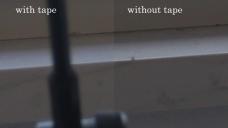
 Zuiko-Test01.jpg1100 x 618 - 353K
Zuiko-Test01.jpg1100 x 618 - 353K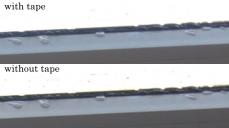
 Zuiko-Test02.jpg1100 x 616 - 277K
Zuiko-Test02.jpg1100 x 616 - 277K -
@proaudio4, to me it's obvious even on the 1080p grabs: http://www.personal-view.com/talks/discussion/comment/18242#Comment_18242 It's not just the shoreline, but the bright water reflection edges are far too hard (especially in the center). You can see in the third shot that it puts a dark halo around those. That makes highlights look digital as they loose their smooth natural rolloff. Actually the whole image looks 'crunchy' and brittle to me.
IIRC on those shots I was experimenting with the simple PTools bitrate adjustment @ ~42mbs (I now use Chris' settings which rock), so that might explain the macro blocks. It's also a difficult scene due to the high contrast. But the footage looks like crap to me because of the sharpening.
I think @LPowell is right, it's worse in the whole vertical center section of the frame, the frame edges are less affected. Lenses can be softer in the corners anyway. But the correction softens the edges more too as they are the most distorted - so the sharpening is too much for the center.
Also Panny's sharpening is strange, it doesn't do much to soft edges, but it massively exaggerates already sharp edges. -
_gl I appaud your excellent tests, but we are looking at 400% here at the shoreline frame. I'm not saying you can't see it at 100%, but with no way to "completely" shut it off, we'll never be exactly 100% confident.
The shot at 400% shoreline frame is so blown up you can see macroblocks everywhere so I would expect them to be even more obvious at contrast edge. But you can definately see the halo at 400% Curious, what hack setting (if any) was the shoreline frame? -
Why stop at sharpness only? Occupy Panasonic. Then demand -3,-3,-3 -3 film mode settings :)
-
No, I noticed it first in 2D (my real-world grabs are 2D). But I get it, it's no big deal for you - many of us disagree. Let's move on.
-
@_gl
Ha, yes, if you're shooting 2-body stereo 3D you're probably better off with AF.
I wonder if the artifacts you see from the digital lens correction are more objectionable when viewing 3D video than they are in 2D. That might explain why it sticks out like a sore thumb to you but doesn't to others.
-
@Shaveblog, an AF lens with contacts covered IS a manual lens. Testing with a 'real' manual doesn't prove anything. And I value AF, especially as I shoot stereoscopic 3D with two bodies - manually focusing each one (and matching them precisely) takes too long.
-
@_gl
If this digital lens correction artifacting bothers you enough to run these tests, you should definitely pick up at least one good legacy lens and M43 adapter. You will probably never shoot video with the pancakes again. And then you'll sell me your 14mm, which I'm looking to pick up. -
@Shaveblog, unfortunately I don't have any manual lenses, only the Panny pancakes.
-
If I'm shooting pro work I record off-camera audio anyway so AGC is actually less of an issue for me than spanning. We're pretty spoiled at this point, really - CBrandin's 32MB (44MB patch's 24L mode) gives noticeably better IQ than stock firmware and keeps spanning intact. I'll love when higher bitrate spanning patches come along but I'm happy with 32MB when I need spanning. I know some guys are hanging it out there with Driftwood's 176MB patch and Henry's 4GB/picosecond patch but back here on Earth I've settled on CBrandin's 44/32 patch as a safe choice for now while the fur's still flying.
Question: have you run your comparisons with a manual lens as a control? I'd be curious to see your same pixel-peep grabs but with a manual lens subbing for the Panacake. In theory no lens correction = no halos but I'd be curious just to put that to bed once and for all. Would you mind slapping an adapted lens on your GH2 and grabbing some caps of those test charts? Thanks _gl. -
@Shaveblog, I hear you (I'm an audiophile too, LOSSLESS baby! : ). I meant of course 'this is the last big *IQ* issue'. As IQ (bitrate) is the current hack focus, it would be good to fix this now (if possible) before moving onto non IQ features.
FWIW, I can't see how high ISO noise can be changed, and 1080-50/60p is unlikely (but I don't mind being wrong about that one : ). But spanning & AGC defeat looks more promising. -
@_gl
For what it's worth, despite my overall satisfaction with hacked GH2/Panacake footage, I applaud your efforts. I used to review high end audio gear and spent a lot of time chasing subtle artifacts that bothered me a great deal but were utterly lost on people who derided my ilk as "nuance seeking buffs". But it's the nuance seekers who push the art forward, not the guys on the sideline who are happy with compromised performance and threatened by anyone who tells them it's not perfect.
FWIW I think there are bigger fish to fry with the GH2 hack. Spanning above 32MB, high ISO noise, 1080p 60p, AGC defeat, etc. But if you and the other big brains here can figure out a way to minimize this issue when shooting with digitally-corrected lenses, it will benefit us all and move this camera even closer to film. -
I can confirm this. And I'm very much in favor of trying to kill sharpening. I have been working with the RED One for years now, and I always appreciated that it doesn't do any sharpening by itself.
Plus, it's much better to add sharpening – if you need any – in the very end. Changing exposure, contrast and color while grading is influencing your impression of sharpness a lot, plus there are better algorithms in professional software then the RT sharpening in a camera. -
@Shaveblog & everyone, I understand where you're coming from. I can see the problems in the chart already (and those seemingly subtle differences do really change the feel of real-world shots) - but actually the chart doesn't tell the whole story. The sharpening is content-sensitive, it's worse on some shots than others.
Check out my real-world shots on Page 1 of this thread (I've attached the blowup here) - the sharpening halos are obscene. This was shot at -2 on the 14mm lens. It seems that lower-contrast areas are less affected, but already high-contrast edges are exaggerated too much. That's why for example blurry background trees don't strobe on LCD displays, but in-focus ones do.
The point is, if you like the sharpness, fine. But if you can disable it you avoid strobing, get back your cinema look (which is never as sharp as the GH2 AF even on modern digital cinema camera movies), you waste less bitrate on the artifical contrast created by sharpening, _and_ you can sharpen in post to get exactly the look you want.
Considering we're all using high bitrates to have more options in post, this is the last big issue that needs to be resolved.
Also re. the 20mm looking 'clinical' - it's the sharpening damnit! : ). Sure it may not be dreamy soft or flarey like some lenses, but it looks 'digital' because of the processing. Try it with contacts covered and see what you think.
As for my workflow, I'm very careful in getting perfect screengrabs. They're taken from the native M2TS files dropped into Premiere CS4, exported as 24bit BMP, and converted to PNG in Photoshop - no additional processing anywhere. Blowups are scaled 400% with nearest-neighbour scaling (no interpolation).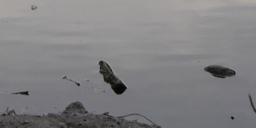
 halos.png1781 x 876 - 174K
halos.png1781 x 876 - 174K -
@_gl took 4 pics above.
1st attachment. corner region. -2 sharpness uncorrected vs -2 sharpness corrected.
2nd attachment. corner region. +2 sharpness corrected vs -2 sharpness corrected.
3rd attachment. center region. -2 sharpness uncorrected vs -2 sharpness corrected.
4th attachment. center region. +2 sharpness corrected vs -2 sharpness corrected.
-2 has a tad bit sharpness. We need -3 sharpness, but I can live with -2. Definitely not a showstopper to me. You know... Panny m43 lenses are simply sharper than legacy lenses. Of course they are optimized for m43. -3,-3,-3,-3 for film modes and 0 for audio level would be great though.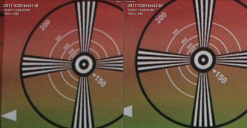
 Screen shot 2011-10-20 at 6.53.22 PM.png1639 x 851 - 301K
Screen shot 2011-10-20 at 6.53.22 PM.png1639 x 851 - 301K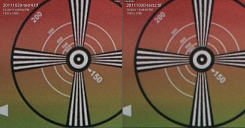
 Screen shot 2011-10-20 at 6.54.06 PM.png1634 x 852 - 304K
Screen shot 2011-10-20 at 6.54.06 PM.png1634 x 852 - 304K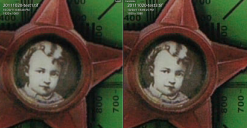
 Screen shot 2011-10-20 at 6.57.33 PM.png1637 x 848 - 311K
Screen shot 2011-10-20 at 6.57.33 PM.png1637 x 848 - 311K
 Screen shot 2011-10-20 at 6.58.03 PM.png1635 x 851 - 320K
Screen shot 2011-10-20 at 6.58.03 PM.png1635 x 851 - 320K -
Has anyone got DxO optics? you could run the uncorrected image through that and see what the difference is with the one corrected incamera
-
@Shaveblog
Agreed...
I'm the first to bitch about sharpening halos. I hardly seeing any sharpening... also, looking at mike's image back a page (or so can't remember), I have never seen it like this (at -2 that is. I have never tried anything else), even magnified green screen or not.
I'm certainly not saying Panasonic is not doing a bit extra here along with the dis correction, it certainly seem small at -2 whatever it is...
-
@LPowell
Wasn't Leicasonic the first dog sent up in space?
I hear you about the 20mm, it's a ruthless little bugger. But somehow every time I shoot with it I love what I see. Ultimately my favorite GH2 video lens is an old Canon FD 35mm f2, the concave Thorium version. But that longish FOV doesn't work for everything. I used to carry around a bunch of primes but these days I just have these two in my bag. I may add the 14mm pancake at some point, just wish it was a bit faster.
-
@Shaveblog
LOL, "Panacake", that's as good as "Leicasonic" (14-50mm f2.8-3.5), which is my choice for a wide-aperture auto-focus zoom. The 20mm f1.7 is, regrettably, a bit too clinical for my taste, though I could see using it to shoot a hard-edged sci-fi scene. I'm currently using Rokinon f1.4 primes and Tokina f2.8 zooms in most of my video shoots:
http://www.personal-view.com/talks/discussion/859/video-friendly-lenses-for-lumix-dslrs#Item_2 -
@LPowell
I read your earlier post about the need for post-correction sharpening "just to get to normal" and it does make sense. Still, I just don't see objectionable edge halos or other sharpening artifacts in the corrected image. Maybe it's just me, but I prefer the overall look of the corrected image in _gl's comparisons to the uncorrected versions.
It's all moot, though, if like me you're just fine with how the Panacakes look shooting video. I definitely am. Wish I had that look in every focal length I shoot.
-
@Shaveblog
In this case,the devil is literally in the details. If Panasonic had not used sharpening in their distortion correction process, the results would have looked blurrier than the original, uncorrected images. Ideally, the less correction required, the less sharpening should be used, but it's more likely they applied a one-size-fits-all unsharp mask to the whole frame. That would oversharpen the center of the image while restoring the sharpness of the corners.
Howdy, Stranger!
It looks like you're new here. If you want to get involved, click one of these buttons!
Categories
- Topics List23,992
- Blog5,725
- General and News1,354
- Hacks and Patches1,153
- ↳ Top Settings33
- ↳ Beginners256
- ↳ Archives402
- ↳ Hacks News and Development56
- Cameras2,367
- ↳ Panasonic995
- ↳ Canon118
- ↳ Sony156
- ↳ Nikon96
- ↳ Pentax and Samsung70
- ↳ Olympus and Fujifilm101
- ↳ Compacts and Camcorders300
- ↳ Smartphones for video97
- ↳ Pro Video Cameras191
- ↳ BlackMagic and other raw cameras116
- Skill1,960
- ↳ Business and distribution66
- ↳ Preparation, scripts and legal38
- ↳ Art149
- ↳ Import, Convert, Exporting291
- ↳ Editors191
- ↳ Effects and stunts115
- ↳ Color grading197
- ↳ Sound and Music280
- ↳ Lighting96
- ↳ Software and storage tips266
- Gear5,420
- ↳ Filters, Adapters, Matte boxes344
- ↳ Lenses1,582
- ↳ Follow focus and gears93
- ↳ Sound499
- ↳ Lighting gear314
- ↳ Camera movement230
- ↳ Gimbals and copters302
- ↳ Rigs and related stuff273
- ↳ Power solutions83
- ↳ Monitors and viewfinders340
- ↳ Tripods and fluid heads139
- ↳ Storage286
- ↳ Computers and studio gear560
- ↳ VR and 3D248
- Showcase1,859
- Marketplace2,834
- Offtopic1,320
Tags in Topic
- hack 405
- sharp 7
- sharpening 2
- aliasing 2











